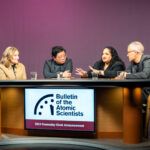An Interview with Malcolm Dando
By Malcolm Dando | April 9, 2008
Which developments in the life sciences pose the greatest threat to humans?
I support the benignly intended civil biotechnology that’s producing a revolution in our understanding of life and opening up positive possibilities such as cures for mental illnesses. I don’t see these developments as a threat. The threat comes from the malign misuse of the knowledge, materials, and technologies produced in the ongoing revolution, which could result in dangerous biological warfare and biological terrorism.
Which developments in the life sciences pose the greatest threat to humans?
I support the benignly intended civil biotechnology that’s producing a revolution in our understanding of life and opening up positive possibilities such as cures for mental illnesses. I don’t see these developments as a threat. The threat comes from the malign misuse of the knowledge, materials, and technologies produced in the ongoing revolution, which could result in dangerous biological warfare and biological terrorism. So we must work on a ‘web of prevention’ to ensure that the possibilities of malign misuse are minimized but don’t stop developments in civil biotechnology. However, we need to conduct biodefense activities carefully and ensure that they are as transparent as possible so that they don’t lead to counterproductive misperceptions, as biodefense is necessarily closely linked to offense and therefore, could easily be misunderstood.
Are states or terrorist groups the actors of greatest concern in terms of biosecurity?
All previous scientific and technological revolutions have been used for both hostile and beneficial purposes. We know that biology was misused in a series of large-scale, state-level offensive biological weapons programs during the twentieth century–for example, in Britain, the United States, and Russia. Preventing more state-level programs seems to be the most important problem as such programs are most likely to accelerate misuse as major resources would become available to those involved. Nevertheless, I don’t dismiss the threat of terrorist misuse, and we need to pay attention to preventing that as well.
What role should international agreements play in regulating the spread of dual-use biotechnologies?
The 1925 Geneva Protocol, the Biological and Toxin Weapons Convention (BTWC), and the Chemical Weapons Convention (CWC) are central to a “web of prevention.” When these international agreements are strong, universal, and deeply embedded by all states parties, we will be in a much better position. Of course, the web would include carefully constructed export control systems directed where necessary to restrict the possibility of misuse–for instance, not allowing easy access to dangerous organisms and genomes.
How do life scientists need to change the way they think about the risks inherent in some of their work?
They need to understand the history of misuse of their science in the twentieth century (anti-animal biological warfare during World War I, antipersonnel biological warfare during World War II, and anti-plant warfare during the Vietnam War), how to prevent that misuse in the future, and how they can contribute to prevention. They also need to understand that the national legal restrictions on their activities will continue as more and more biosecurity measures in restrictions on access, transfers, and so on supplement biosafety measures. So there is no real alternative to being well informed, and no excuse for not being informed as there is an abundance of easily available information on the web.
Under what circumstances would it be appropriate for a state to use nonlethal biochemical agents?
I’m among those who believe that the attempt to develop novel, so-called ‘nonlethal’ agents poses a real threat to the entire chemical and biological weapons prohibition regime. I see the use of some kind of opiate agent by the Russian government to break the Moscow theater siege in 2002 as an indication of the terrifying possibilities further advances in neuroscience could create. I would like to see the Second Review Conference of the Chemical Weapons Convention clarify Article II.9 (d), which states that one peaceful purpose exemption from the prohibition is “law enforcement, including domestic riot control.” This could lead some to believe that novel chemicals could be exempt if developed for law enforcement. To avoid that danger, I would like to see the ‘law enforcement’ exemption be greatly restricted. At the very least, there should be declarations of what substances are being held for law enforcement, in what quantities, and how they are to be dispersed to minimize misperceptions.
Predict the state of global biosecurity in 2040.
There are three general possibilities–benign, malign, and in between! A benign future would involve flourishing civil biotechnology protected from misuse by a strong web of preventive policies centered on strengthened international agreements such as the BTWC and CWC. A malign future would involve the efforts to construct the web of prevention in disarray and the massive misuse of bioscience pushed forward by the efforts of many talented scientists in new offensive biological weapons programs. Both of these outcomes seem possible, but I don’t think that we can remain in our present ‘in between’ situation–with holes such as the law enforcement problem in the CWC and deficiencies such as the lack of verification of the BTWC in the web of prevention and our scientific communities lacking the knowledge and awareness necessary to assist in the protection of their science from abuse. So we need to make some hard choices soon, or we may see the revolutionary new life sciences transforming the nature of conflict and greatly destabilizing international security.
Together, we make the world safer.
The Bulletin elevates expert voices above the noise. But as an independent nonprofit organization, our operations depend on the support of readers like you. Help us continue to deliver quality journalism that holds leaders accountable. Your support of our work at any level is important. In return, we promise our coverage will be understandable, influential, vigilant, solution-oriented, and fair-minded. Together we can make a difference.
Topics: Uncategorized















